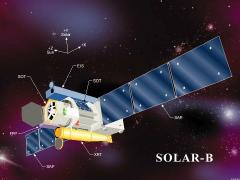Hinode Mission
Hinode is a joint Japan/UK/US mission with ESA and Norwegian involvement. Using a
combination of optical, EUV and X-ray instrumentation Hinode is studying the interaction
between the Sun's magnetic field and its corona to increase our understanding of the causes
of solar variability and the origins of solar activity.
Hinode was launched in September 2006
on an ISAS (Institute of Space and Astronautical Science)
M V rocket. It was placed in a polar sun-synchronous orbit with an
inclination of 97.9
degrees; the nominal mission lifetime was 3 years.
The instrumentation on Hinode includes a 0.5m optical telescope ( SOT ), an EUV imaging
spectrometer ( EIS ) and an X-ray/EUV telescope ( XRT ).
The instruments work together as an observatory making coordinated observations.
The EUV Imaging Spectrometer (EIS) was built by a
consortium that was led by UCL's Mullard Space Science Laboratory (MSSL)
and included NRL and NAOJ.
Below is an artist's impression of the Hinode spacecraft in orbit showing the location of all
three instruments.
 |
Click on image for larger version. |
Last Revised: 11-Jan-2020
Feedback and comments: webmaster
|


